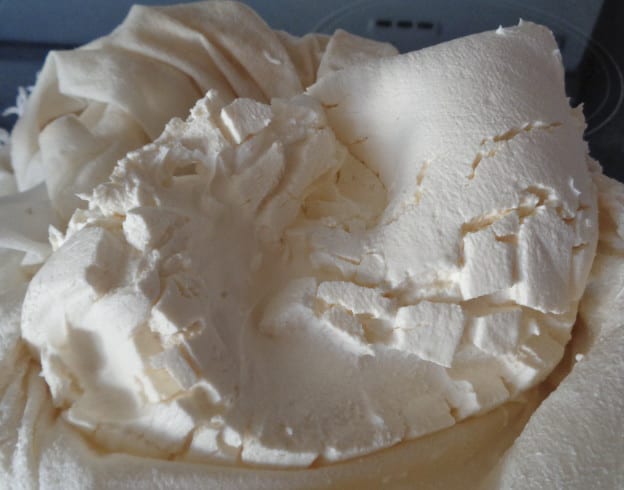The reason that milk and soft cheese is so much a part of Imbolc (also known as Brigid’s Day) is that farms with sheep and cows were busy with new little ones, meaning their moms had milk to give, both for their babies and the household. Fresh milk meant, fresh butter and fresh cheese and proof that life was returning to the land.
Brigid, at this time of the year, was seen as the goddess of fertility, midwifery and the young, making life nourishing milk an understandable part of the season and the first of the fresh cheese would be part of the celebration.
Cream style cheese can be made quickly using acids to activate the separating process as in this previous post and this one.
It can also be made by adding a culture as in the recipe below. It is not a lot of work. It just takes time but gives a wonderfully creamy cheese once the dripping has ceased.
Rennet can be found online and very possibly through a local gourmet cooking store. Sometimes stores will even cut up a packet of tablets so there is no need to purchase the entire box. Keeps the tablets fresh as 2 tablets could make 16 batches of this recipe.
I was using up containers in the fridge and that is why there is one cup 2%. There is no reason not to substitute whole milk or buttermilk in its place. I have also used this process with equal thirds of whipping cream, buttermilk and whole milk to good results.
I was really happy with how this came out. Good for snacks, dips, fillings, sandwiches and cheesecake.
You will need:
1 cup 2% milk
4 cups cultured buttermilk
5 cups whipping cream (33 – 35% fat content)
1/8 tablet of rennet in 2 Tbsp. warm water
2 tsp. salt
Cheese and yoghurt making require an extra level of cleanliness and washing “clean” pots and rinsing well before using them is not a bad idea. I sometimes run mine through the dishwasher if I have cheesemaking plans.
When washing by hand in all that soapy water, let your fingers relax and focus on the heat, allowing it to take away the stresses within. Let go of all that bothers you and see it draining out of your warmed fingers, into the water and down the drain. Rinse the pot and other equipment, holding on to the knowledge that the returning light brings with it new opportunities for growth. Focus on the present moment in your kitchen while inviting the compassionate spirits. “In my kitchen filled with care, I welcome, Earth, Water, Fire, Air“. Begin.
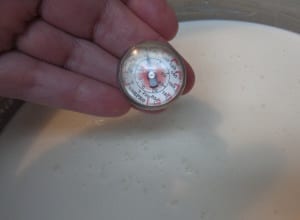 Warm up the buttermilk, whipping cream and milk, if using, in a large nonreactive pot (stainless steel is a good choice), until the temperature reaches about 70°F (~21°C).
Warm up the buttermilk, whipping cream and milk, if using, in a large nonreactive pot (stainless steel is a good choice), until the temperature reaches about 70°F (~21°C).
Don’t let the mixture get hot enough to boil, not that it will when aiming for 70°F.
This is really more of a reminder to not walk away and forget about the heating milk.
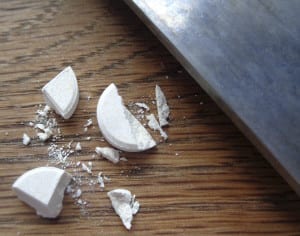 When the temperature is almost high enough, cut the tablet into pieces. It can crumble a little so collect up all the bits when measuring.
When the temperature is almost high enough, cut the tablet into pieces. It can crumble a little so collect up all the bits when measuring.
If you have liquid rennet handy at home then 2 – 3 drops will also do the job.
When using rennet tablets it is not a good idea to let the water sit once the tablet has dissolved.
Sprinkle the rennet liquid over the milk mixture and using a slotted spoon and up and down motions (not stirring ones) mix.
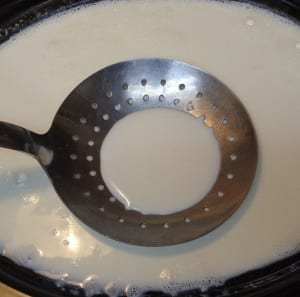 Put the lid or a plate over the pot and allow it to sit at room temperature overnight.
Put the lid or a plate over the pot and allow it to sit at room temperature overnight.
The following morning, the mixture will have thickened and it is time to sprinkle the salt over the surface of the curds.
Using a large wire whisk or knife, cut the semi solid mass into small curds.
Line a large colander with a piece of muslin cloth. I have used the piece you see here for over twenty years and I would choose this style of cloth over cheesecloth every time. It holds the curbs together, increasing the amount of finished product and is much easier to work with than a flimsy cheesecloth.
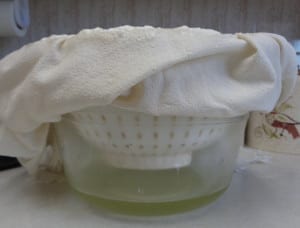 Place the colander on a bowl large enough to contain the whey and high enough to create separation space between the bottom of the seive and the bottom of the bowl.
Place the colander on a bowl large enough to contain the whey and high enough to create separation space between the bottom of the seive and the bottom of the bowl.
Transfer the contents of the pot into the colander and let it drain. After 30 minutes, if you have a location bring the corners of the muslin together and form a bag for the cheese. It can be tied around the faucet of your sink with the bowl sitting beneath it. Another option is to use a strong line, loop it over the top of an upper cupboard door and secure the bag of cheese over the drain bowl. The cheese can also continue to drain from the seive. In all cases keep an eye on the level on whey in the bowl and pour it out (NOT AWAY) if the whey it touching the bottom of the dripping cheese.
There are many things that you can do with whey. Substitute it for water in bread making. Many animals love it ( you might too in a lemonade style drink ) and so do plants once seriously diluted. Soak grains, beans and nuts; preserve foods; use instead of apple cider vinegar in caramels; add to smoothies; brine your next batch of Feta or the Thanksgiving turkey; soda, ginger ale and lemonade ( sour style summer cool down drinks ). Freeze it! Whey is full of “good stuff”. It is the basis of that expensive protein powder at the health food store and down the drain is the last thing to do with what is leftover from your cream cheese making adventures.
There is a case to be made for letting the cheese drip at room temperature and for putting it in the fridge and letting it drip there. If the choice is to allow it to drip in the fridge, it will take about 20 – 24 hours to finish off. Allowing the cheese to drip at room temperature should take less than half that time.
Once complete, stir the mixture as there will be firmer sections towards to outside and softer, creamier section inside. Transfer the cream cheese to a container and store in the fridge.
It is also possible to flavour the cream cheese by adding extra ingredients, roasted garlic, sundried tomatoes, fresh herbs, raspberry puree, chocolate, honey. The choices are endless. If you can wait that long, allowing the mixture to sit for an hour or so will let the flavours blend and mature.
Get out the crackers or bagel and enjoy.
Cream Cheese from My Kitchen Wand

